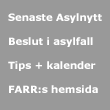ASYLNYTT
Sponsrad av Fridh Advokatbyrå
ARKIV:
EU:s flykting- och gränspolitik
Allmänt om migration, statistik

Asylnytt - Arkiv
EU:s flykting- och gränspolitik
Personregister och IT-system
Information från myndigheter och organisationer
- Arkiveringsdatum 220607:
- Statewatch: Council to push for biometric ID checks, inserting "all available data" in SIS
- Arkiveringsdatum 220518:
- Picum: Regulating migration tech: How the EU's ai act can protect people on the move
- Arkiveringsdatum 210603:
- Viseringsregistret: rådet antar förordning om skärpta kontroller av viseringssökande
- Arkiveringsdatum 200715:
- Picum: EU to create massive database to match biometric data for immigration control
- Arkiveringsdatum 190620:
- EU-kommissionen: Security Union: New rules closing information gaps become law 3 class="normal"> EU - Sambandsmän info Sambandsmän för invandring: rådet antar nya regler för att förbättra samordningen
Arkiveringsdatum 220607:
Statewatch 22-05-19:
Council to push for biometric ID checks, inserting "all available data" in SIS
The Council of the EU is set to call for "an ambitious implementation" of new rules on EU policing and immigration databases, including "on the spot" biometric ID checks with mobile fingerprint readers and face scanners; ensuring that "all available data" from national databases is added to the Schengen Information System; and enabling "full use of discreet checks, inquiry checks and specific checks," which allow the gathering of information about targeted individuals.
Draft conclusions
The calls are set out in a draft set of conclusions (pdf) dealing with "the implementation of the EU information systems and their interoperability at national level," and come after a survey of the member states revealed that half "foresee high risks" to the plan to have the biometric Entry/Exit System (EES) border crossing database up and running by the end of September this year.
The conclusions focus on the EES and another database, the Schengen Information System, which contains some 90 million alerts on people and objects used by police, immigration and judicial authorities.
Legislation establishing the EES was approved in November 2017, while revamped laws underpinning the SIS were given the green light a year later.
The forthcoming Common Identity Repository (CIR), intended to hold biometric data on hundreds of millions of foreign nationals, also features in the draft conclusions, which are not legally binding, but are intended to place political pressure on member states to take action.
Biometric identity checks
The document urges member states to ensure that they have laws in place to allow searches of the CIR using biometric data, "in particular for the purpose of facilitating the correct identification of persons," under Article 20 of the interoperability rules.
(...)
Hela artikeln (Extern länk)
Statewatch 22-04-11: Biometric borders: half the member states see "high risks" for Entry/Exit System plans (Extern länk)
Arkiveringsdatum 220518:
Picum 22-05-09:
Regulating migration tech: How the EU's ai act can better protect people on the move
As the European Union amends the Artificial Intelligence Act (AI Act), understanding the impact of AI systems on marginalised communities is vital. AI systems are increasingly developed, tested and deployed to judge and control migrants and people on the move in harmful ways. How can the AI Act prevent this?
From AI lie-detectors, AI risk profiling systems used to assess the likelihood of movements outside the limited scope of regular pathways, to the rapidly expanding tech-surveillance at Europe's borders, AI systems are increasingly a feature of the EU's approach to migration.
On the 'sharp-edge' of innovation
While the uptake of AI is promoted as a policy goal by EU institutions, for migrants and people on the move, AI technologies fit into a wider system of over-surveillance, discrimination and violence. As highlighted by Petra Molnar in Technological Testing Grounds: Migration Management Experiments and Reflections from the Ground Up, AI systems are increasingly used in efforts to restrict migration, affecting millions of people on the move. In this context, more and more 'innovation' means a 'human laboratory' of tech experiments, with people in already dangerous, vulnerable situations as the subjects.
How do these systems affect people? AI is used to make predictions, assessments and evaluations about people in the context of their migration claims. Especially worrying is the systematic use of AI to assess whether people who want to come to or enter Europe present a 'risk' of unlawful activity or security threats. These systems tend to pre-judge people based on factors outside of their control, relying on discriminatory assumptions and associations. Along with AI lie detectors, polygraphs and emotion recognition, we see how AI is being used and developed within a broader framework of racialised suspicion against migrants.
(...)
Läs mer (Extern länk)
Se även:
Picum May 2022: DIgital technology, policing and migration - what does it mean for undocumented migrants? (Extern länk)
Statewatch 22-05-12: A clear and present danger: Missing safeguards on migration and asylum in the EU's AI Act (Extern länk)
Arkiveringsdatum 211210:
Statewatch 21-11-30:
Presidency compromise proposals on revamped Eurodac database
The controversial expansion and extension of the Eurodac database is moving ahead, with compromise proposals circulated by the Slovenian Presidency of the Council last week. The legislation would extend Eurodac from a system concerned with supporting the implementation of the EU's asylum rules, to a more general "migration management" database, with a big emphasis on providing data for deportations.
The compromise proposals are mainly made up of articles intended to ensure that Eurodac is 'interoperable' with other EU databases, in particular the Visa Information System (VIS), European Travel Information and Authorisation System (ETIAS) and Common Identity Repository (CIR).
The connections between different systems will be used to screen visa and travel authorisation applicants, and the inclusion of new data categories in Eurodac is designed to make it simpler to carry out deportations of people deemed to have no right to stay in the EU.
(...)
Hela artikeln med länkar (Extern länk)
Läs förslaget till ändrad förordning här, på svenska: COM/2020/614 final (Extern länk)
Arkiveringsdatum 210603:
Europeiska unionens råd 21-05-27:
VIS: Rådet antar förordning om skärpta kontroller av viseringssökande
Som svar på de förändrade migrations- och säkerhetsutmaningarna vill EU förbättra sitt informationssystem för viseringar (VIS) - ett verktyg som medlemsländernas myndigheter använder för att registrera och kontrollera personer som ansöker om visum för kortare vistelse i Schengenområdet. Rådet har i dag antagit en förordning om ändring av informationssystemet för viseringar. Rättsakten måste nu antas av Europaparlamentet och undertecknas innan den offentliggörs i EU:s officiella tidning.
Ändringsförordningens huvudsakliga mål är att
- ytterligare stärka säkerheten i förfarandet för visum för kortare vistelse
- inkludera visum för längre vistelse och uppehållstillstånd i VIS-databasen
- säkerställa interoperabilitet mellan VIS och andra i sammanhanget relevanta EU-system och EU-databaser.
Enligt de nya reglerna ska VIS innehålla information inte bara om visum för kortare vistelse, som tidigare, utan även omfatta visum för längre vistelse och uppehållstillstånd, eftersom dessa dokument ger innehavaren möjlighet att röra sig fritt inom Schengenområdet. Dessutom ska en skanning av sidan med biografiska uppgifter i resehandlingen läggas in i VIS.
De nya reglerna skulle möjliggöra förbättrade bakgrundskontroller av sökanden, innan ett visum eller uppehållstillstånd utfärdas, i relevanta säkerhets- och migrationsdatabaser. VIS skulle automatiskt inleda en sökning i dessa databaser och eventuella träffar kontrolleras manuellt och följs upp av den behöriga myndigheten.
Bakgrund
(...)
Läs mer (Extern länk)
Arkiveringsdatum 200715:
PICUM 20-07-10:
EU to create massive database to match biometric data for immigration control
The EU has reportedly entered into a contract with technology companies IDEMIA and Sopra Steria to build a system that supports immigration control through the scaled-up use of biometric data. The shared Biometric Matching System (BMS) will allow the cross-matching of fingerprints and facial images across several EU information systems (Schengen Information System, Eurodac, Visa Information System, the future Exit-Entry System and ECRIS-TCN). These systems store the data of millions of foreigners, including those who have applied for a short-term visa or for asylum. The BMS, which is one component of the EU's framework to make migration databases more interconnected (or "interoperable"), is expected to be "one of the largest biometric systems in the world". Advocates have expressed concerns about the fundamental rights implications of the BMS and the interoperability systems more generally.
Picum Newsletter (Extern länk)
EurActiv 20-06-04: EU signs contract for large-scale biometric database to protect borders (Extern länk)
Picum, Statewatch report November 2019: Data protection, immigration enforcement and fundamental rights: What the EU's regulations on interoperability mean for peoplewith irregular status (Extern länk till pdf-fil)
Arkiveringsdatum 200306:
EU-kommissionen 20-02-28:
Läget inför genomförandet av nya rättsliga grunder för Schengens informationssystem
RAPPORT FRÅN KOMMISSIONEN TILL EUROPAPARLAMENTET OCH RÅDET om läget i förberedelserna inför det fullständiga genomförandet av de nya rättsliga grunderna för Schengens informationssystem (SIS) i enlighet med artikel 66.4 i förordning (EU) 2018/1861 och artikel 79.4 i förordning (EU) 2018/1862
Den 28 november 2018 antog Europaparlamentet och rådet tre nya förordningar om inrättande, drift och användning av Schengens informationssystem (SIS)1. De nya SIS-förordningarna breddar tillämpningsområdet för och funktionerna i SIS på följande områden:
+ Nya kategorier av registreringar och fler möjligheter med befintliga kategorier av registreringar.
+ Utökade uppgiftskategorier i registreringar i SIS.
+ Nya tekniska möjligheter.
+ Nya biometriska funktioner.
+ Ökad åtkomst till registreringar i SIS på nationell och europeisk nivå.
De nya bestämmelserna kommer att införas i olika faser. Följande milstolpar för genomförandet fastställs i förordningarna:
1 )Genomförandefas I (ska inledas vid slutet av 2019): Europol och medlemmar i de enheter och grupper som utplaceras av Europeiska gräns-och kustbevakningsbyrån (Frontex) får åtkomstbehörighet till samtliga kategorier av registreringar i SIS.
2) Genomförandefas II (ska inledas vid slutet av 2020): Alla medlemsstater kan använda det automatiska systemet för identifiering av fingeravtryck (Afis) för sökningar på grundval av fingeravtryck i SIS.
3) Genomförandefas III (ska inledas vid slutet av 2021): Fullständigt genomförande av de nya SIS-förordningarna
Hämta dokumentet, COM(2020) 72 final (Extern länk till pdf-fil)
Arkiveringsdatum 190620:
EU-kommissionen 19-06-12:
Security Union: New rules closing information gaps become law
Yesterday, new rules to make European security, migration and border management information systems work together in a more intelligent and targeted way became law. A political priority for 2018-2019Search for available translations of the preceding linkEN+++, the interoperability measures will ensure that border guards and police officers have access to the right information whenever and wherever they need it to perform their duties. The new measures will help them detect identity fraud more easily while ensuring the highest standards of data protection and respect for fundamental rights. It is now over to the eu-LISA Agency, which is responsible for the management of the large-scale IT systems in the area of freedom, security and justice, to begin the work of developing the interoperability tools.
The systems becoming interoperable include the Entry/Exit System (EES), the European Criminal Records Information System (ECRIS-TCN), the Schengen Information System (SIS), the Visa Information System (VIS) and the European Travel Information and Authorisation System (ETIAS). The new rules require the development of 4 technical components, including a European Search Portal, a shared Biometric Matching Service, a Common Identity Repository and a Multiple Identity Detector. The work is expected to be complete by 2023.
In the meantime, the Commission will assist Member States in implementing the Interoperability Regulations.
Pressmeddelandet (Extern länk)
Källor: Informationen på denna sida är hämtad från följande källor (externa länkar): EU (kommissionen, ministerrådet, parlamentet och domstolen), Europarådet (mr-kommissionären, domstolen, kommittén mot tortyr), FN:s flyktingkommissariat UNHCR, FN:s kommitté mot tortyr m.fl. FN-organ, Sveriges Radio, SvT, andra svenska media via Nyhetsfilter och pressmeddelanden via Newsdesk, utländska media till exempel via Are You Syrious och Rights in Exile, internationella organisationer som Amnesty International, Human Rights Watch, ECRE, Statewatch och Picum, organisationer i Sverige som Rädda Barnen, Asylrättscentrum, Svenska Amnesty, FARR och #vistårinteut samt myndigheter och politiska organ som Migrationsverket, Sveriges domstolar, JO, Justitiedepartementet m.fl. departement och Sveriges Riksdag.
Bevakning: Hjalte Lagercrantz och Sanna Vestin. Sammanställning: Sanna Vestin. Asylnytt är ett ideellt projekt. Sponsring avser prenumerationsavgifter. Tips emottages tacksamt.

 innehåll
innehåll